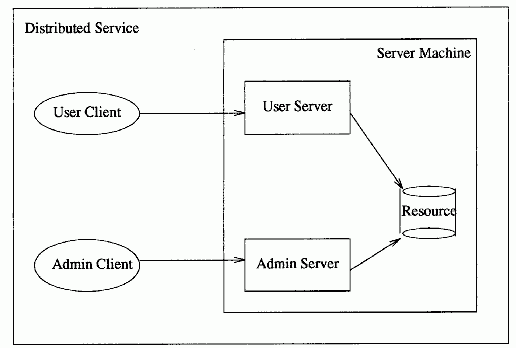Basic Configuration Components
DCE software can be divided into several configuration components; that is, parts of the DCE software that are installed in various combinations on DCE machines. Different configuration components are installed on different machines in a DCE environment, depending on what the machine's intended use is. For example, a user's workstation that acts mainly as a client in the DCE environment requires a different set of DCE software from a machine that acts as a DFS file server.
The following description is a model for dividing DCE services into configuration components. The way a service's implementation maps to this model varies from service to service.
First, each DCE service can be divided into two general categories of functionality, user and administration. The user functionality is the service provided to its users; for example, reading a file or searching a database. The administration functionality allows administrators to manage the server; for example, stopping and starting server programs or backing up data.
Since the DCE services are based on the client/server model, both the user and administration functions are divided into two parts - the client and server sides. In total, each DCE technology component can be conceptually divided into four configuration components:
· User client
· User server
· Administration client
· Administration server
As shown in the following figure, the user client communicates over the network with the user server, and the administration client communicates over the network with the administration server.
Distributed Service Configuration Components

The user client component is typically installed on DCE users' workstations. The administration client might run only on the workstation used by the administrator of the service. Both the user server and the administration server run on the server machine, since they require access to the resource (such as a database) that the server manages. The user server and administration server may actually run in the same process, or be implemented by several processes.
As an example, consider the DCE security service. One part of the security service software is the login facility, which sets up a user's security environment. This is an example of a user client. It communicates over the network with the privilege server, which runs on the security server machine. The privilege server is an example of a user server. An example of an administration client in the security service is the rgy_edit program, which administrators use to modify data in the security database. It communicates over the network with the registry server, which runs on the security server machine. The registry server is an example of an administration server.
The software for each of the DCE services, namely the directory service, the Distributed Time Service, the security service, and the Distributed File Service, can all be divided roughly into these four configuration components.
DCE Threads and DCE RPC are separate configuration components. They help to implement the communications between machines, so they must be present on every DCE machine, whether the machine acts as a client or a server.
DCE Machine Configuration Examples describes how machines participating in a DCE environment are configured, using various combinations of configuration components. The topic titled DCE Cell Configuration Examples describes how DCE cells are configured, using various combinations of DCE machines.